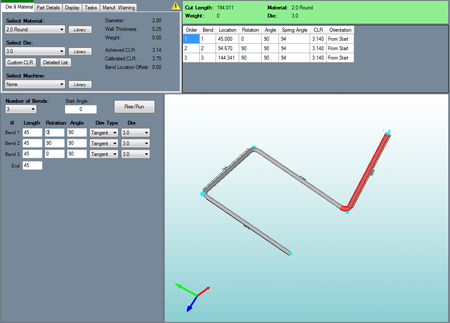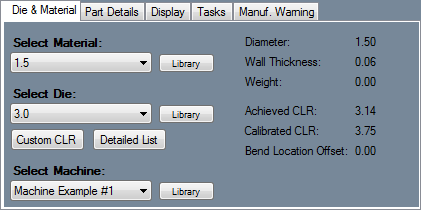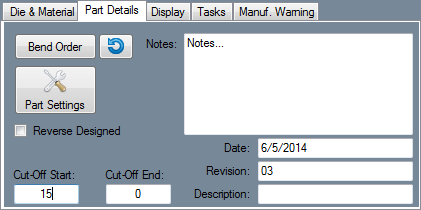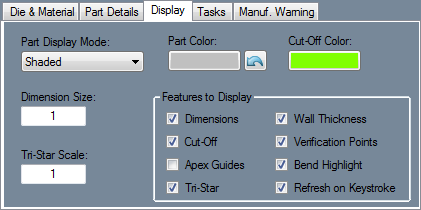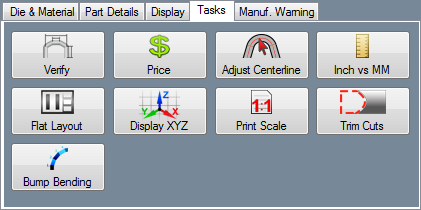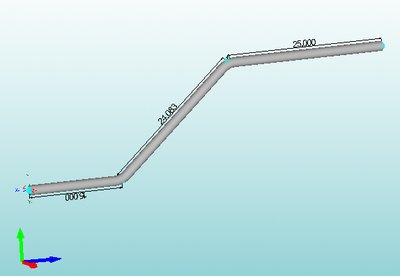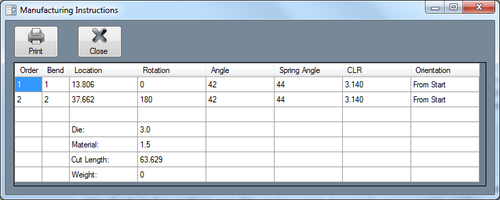Difference between revisions of "Single Part -Interface/General Functions"
| Line 125: | Line 125: | ||
Click the '''Bump Bending''' button [[File:bumpbending.png]] to add bump bends to a bend on the current part. Bump Bending allows bends to be sectioned off into multiple smaller, equal sized bends. | Click the '''Bump Bending''' button [[File:bumpbending.png]] to add bump bends to a bend on the current part. Bump Bending allows bends to be sectioned off into multiple smaller, equal sized bends. | ||
| − | |||
| − | |||
| − | *'''Price:''' | + | *'''[[Price]]:''' |
| − | Click the 'Price' button to access the Price List. In this menu the total costs for a single part, along with a specified amount of the current part can be seen | + | Click the '''Price''' button [[File:price.png]] to access the Price List. In this menu the total costs for a single part, along with a specified amount of the current part can be seen. |
| Line 149: | Line 147: | ||
*'''Adjust Centerline:''' | *'''Adjust Centerline:''' | ||
| + | |||
| + | *'''Timing:''' | ||
Revision as of 10:39, 4 June 2014
Bend-Tech 7x Wiki :: Single Part - Interface/General Functions
Whenever a single part (Template, Custom Part, Custom 3D Part, XYZ Part, Sketch 3D, Sketch 2D, Reverse Design, or Straight Part) is being created, the interface will generally be the same for each with the exception of the part information/creation section below the tabbed menu.
The screen is broken up into four sections with a small icon menu near the top of the frame. The top right corner holds the tabbed section, the top left corner holds the results table, the bottom left is the 3D part display, and the bottom right is the part information/creation section.
Icon Toolbar
At the top of the frame just below the main menu bar, there is a series of icons.
Click the New Part icon ![]() to open the create new menu. This menu will allow you to choose a new part designer interface and begin a new part design.
to open the create new menu. This menu will allow you to choose a new part designer interface and begin a new part design.
Click the New Assembly icon ![]() to open a new assembly design. See the Assembly page for further information on creating an assembly.
to open a new assembly design. See the Assembly page for further information on creating an assembly.
Click the New Plate icon ![]() to open a new plate design. See the Plate page for further information on designing a plate.
to open a new plate design. See the Plate page for further information on designing a plate.
Click the New Header icon ![]() to open a new header design. See the Header page for further information.
to open a new header design. See the Header page for further information.
Click the Open icon ![]() to open a part, assembly, plate, or header file.
to open a part, assembly, plate, or header file.
Click the Save icon ![]() to save the current active window's progress. If the current window is a new and hasn't been saved previously, the part will need to be given a name and location. Click 'Save' in the Save window to save.
to save the current active window's progress. If the current window is a new and hasn't been saved previously, the part will need to be given a name and location. Click 'Save' in the Save window to save.
Click the Print icon ![]() to print the part's setup sheet. To add or remove anything from this page, check/uncheck any of the printing options in the Settings tab in the tabbed section near the upper left corner of the part design frame.
to print the part's setup sheet. To add or remove anything from this page, check/uncheck any of the printing options in the Settings tab in the tabbed section near the upper left corner of the part design frame.
Click the Print Preview icon ![]() to view a preview of the setup sheet. Use the icons in the top left corner to adjust the zoom and the amount of pages shown. Click the 'Print' button to print the setup sheet. Click 'Close' to close the print preview without printing.
to view a preview of the setup sheet. Use the icons in the top left corner to adjust the zoom and the amount of pages shown. Click the 'Print' button to print the setup sheet. Click 'Close' to close the print preview without printing.
Click the Solidworks icon ![]() to import a part file from Solidworks that has been sent to Bend-Tech.
to import a part file from Solidworks that has been sent to Bend-Tech.
Click the Display menu ![]() to alternate between a line or shaded part model.
to alternate between a line or shaded part model.
Click the Refresh icon ![]() to refresh the part display.
to refresh the part display.
Click the Home button ![]() to reset the 3D part display to its original default view.
to reset the 3D part display to its original default view.
Click the Zoom button ![]() to zoom all the way in on the current view of the 3D part display and fit it to the display frame.
to zoom all the way in on the current view of the 3D part display and fit it to the display frame.
Click on the Transfer menu ![]() to send the current part design to any of the other part designers, a new or current assembly design, a new or existing nesting project, the offset part interface, or the break part interface.
to send the current part design to any of the other part designers, a new or current assembly design, a new or existing nesting project, the offset part interface, or the break part interface.
Click on the Projections icon ![]() to view the current part model from a specified plane (top, bottom, left, right, front, or back) or from a certain angle.
to view the current part model from a specified plane (top, bottom, left, right, front, or back) or from a certain angle.
Tabs
In the top right corner, there is a tabbed section that holds a majority of the design options.
Die & Material
Under the Die & Material tab, the material and die can be chosen.
To select a die, choose one from the drop down menu below 'Select Material:'. To see more detailed information about each material, click the 'Library' button next to the material menu to view the material library. To the right of the material selection, the diameter, wall thickness, and weight of the selected material will be displayed.
To select a die, choose one from the drop down menu below 'Select Die:' or click the 'Detailed List' button. Once the 'Detailed List' button has been clicked, a new window containing a chart of every die in the die library along with detailed information about each. To select a die from this list, click on a die and click the 'Select' button or double click on the desired die. To print this list, click the 'Print' button. Click the 'Library' button next to the die menu to view the die library.
To create a custom die CLR, click the 'Custom CLR' button. Enter the CLR value and click 'OK'. This will add the entered CLR value to the drop down menu as 'Custom CLR - (Entered Value). Select the custom CLR from the menu to use it.To the right of the die selection, the CLR, calibrated CLR, and bend location offset of the selected die will be displayed. Check the box next to 'Display Spring Angle' to have spring angle values included in the results table.
Part Details
Under the Part Details tab, notes, revision information, part description, cut-off start/end values, and the bend order menu can be accessed. To add notes, type in the field below 'Notes:'. Any notes shown here will be included on the setup sheet. To set a default note, Select 'Options' under the 'Tools' menu and go to the Single Parts tab. If desired, enter any revision information next to 'Revision:' and a description next to 'Description:'.
Enter any cut-off values into the 'Cut-Off Start' and/or 'Cut-Off End' fields. These cut-off values are the amount of extra material needed on either end of the part when bending.
Bend Order: Click the Bend Order button ![]() to access the 'Part Bending Order' menu. In this window, a simulation of the part being bent is shown along with settings and bending options. See the Bend Order page for further information on this feature.
to access the 'Part Bending Order' menu. In this window, a simulation of the part being bent is shown along with settings and bending options. See the Bend Order page for further information on this feature.
Display
Under the Display tab, settings specific to the 3D part display can be adjusted in this tab. Click the button below 'Cut-Off Color' to change the color that cut-off lengths will be displayed in. This button will display the current color that is in use. To change the size of the Tri-Star or Dimension text, enter values into either of the 'Tri-Star Scale' or 'Dimension Size' field.
Check the box next to 'Display Dimensions' to have the length measurements and markers displayed in the part display (Specific to Template).
Check the box next to the 'Verification Points' to display blue points on each bend and the start and end of the part (Specific to Template).
Check the box next to 'Display Cut-Off' to have any cut-off lengths that were entered in the 'Cut-Off Start or End' fields in the Part Display tab shown in the part display.
]Check the box next to 'Display Apex Guides' to to show lines extending from the bend verification points to the part.
Check the box next to 'Display Tri-Star' to have the XYZ compass/tri-star displayed in the part display. Check the box next to 'Display Material Thickness' to have the hollow center of the tube (determined by the chosen material's wall thickness) displayed instead of just a solid part.
While any of these options are unchecked, they will not be shown in the 3D part display.
Tasks
Click the Verify button ![]() to open the Part Verify tool. Using this tool, the dimensions/distances and the angle between two points can be verified.
to open the Part Verify tool. Using this tool, the dimensions/distances and the angle between two points can be verified.
Click the Flat Layout button ![]() to open the Flat Layout window. Two flat, unbent models of the same part will be displayed and can be labeled and then printed out.
to open the Flat Layout window. Two flat, unbent models of the same part will be displayed and can be labeled and then printed out.
Click the Bump Bending button ![]() to add bump bends to a bend on the current part. Bump Bending allows bends to be sectioned off into multiple smaller, equal sized bends.
to add bump bends to a bend on the current part. Bump Bending allows bends to be sectioned off into multiple smaller, equal sized bends.
Click the Price button ![]() to access the Price List. In this menu the total costs for a single part, along with a specified amount of the current part can be seen.
to access the Price List. In this menu the total costs for a single part, along with a specified amount of the current part can be seen.
- Display XYZ/LRA: (Excludes XYZ Part Design)
Depending on which coordinate mode is in use in the Results Table, this button will display either 'Display XYZ' or 'Display LRA'. When one mode is in use, the opposite will be shown on this button. Click this button to toggle between them. The results tables for the same part are shown below; LRA table on the left and XYZ table on the right.
- Move to Origin: (Specific to XYZ Part)
Click the 'Move to Origin' button will make it so the starting point of the part will be located at (0, 0, 0). All other points on the point will be adjusted accordingly, so the design will remain the same once the origin is shifted.
- Trim Cuts:
- Inch vs MM:
Clicking the 'Inch vs MM' button will convert the current units to the other. These changes will be shown in the results table, part information/design section, and 3D part display.
- Apex vs Tangent:
- Print Scale:
- Adjust Centerline:
- Timing:
Manuf. Warning
Under the 'Manuf. Warning' tab, manufacturing warnings will be listed if any are available. While there are warnings, a red block will be displayed above the tab. The bend number, description of the problem, and any action that can be taken will be listed for each warning. If an auto-fix is available, double-click on the auto-fix description to execute the auto-fix.
Part Display
On the lower right side of the window is the 3D preview of the part. While creating a Custom, Custom 3D, XYZ, or Reverse Design part, the current bend and/or length will be highlighted in red while the bend is either selected or while the bend/start/end coordinate row is clicked in. This preview can be adjusted by zooming, panning, and rotating. To zoom, use the scroll wheel on the mouse. Scroll up to zoom out and scroll down to zoom in. To pan/move the part preview, click and hold the scroll wheel or both mouse buttons and move the cursor around. The part preview will move with the cursor. To rotate, click and hold the right mouse button. Move the cursor around and the part will rotate with the cursor movements.
Results Table
In the upper right corner of the window, the results table is shown. The top section of the results table shows the die, material, cut length, and weight of the part. This entire section's color will indicate if any problems exist. If the section is green, it means the part is complete and there are no problems or manufacturing warnings. If section is orange, the part is complete, but some problems or warnings exist. If the section is red, the part is not complete and/or there are warnings or problems with the part design. The results table also holds a chart that lists each bend along with the bend order, location of the bend, amount of rotation needed for the bend, angle of the bend, spring angle value, centerline rotation, bend length, and the orientation of the bend. Double click within this chart to view a full size version in a new window. In this new window, click the 'Print' button to print the chart.
